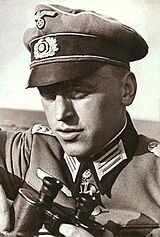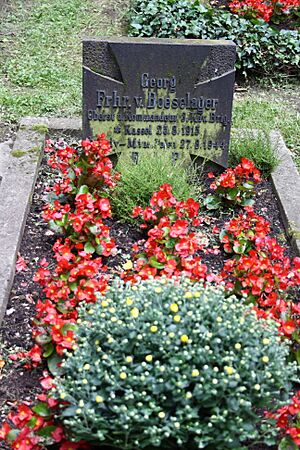Georg von Boeselager facts for kids
Quick facts for kids
Georg von Boeselager
|
|
|---|---|
 |
|
| Born | 25 August 1915 Kassel, Kingdom of Prussia |
| Died | 27 August 1944 (aged 29) Łomża, German-occupied Poland |
| Allegiance | Nazi Germany |
| Years of service | 1934–1944 |
| Rank | Oberst |
| Battles/wars | Invasion of Poland Battle of France Eastern Front Nazi security warfare |
| Awards | Knight's Cross of the Iron Cross with Oak Leaves and Swords |
| Relations | Philipp von Boeselager |
Georg von Boeselager (born August 25, 1915 – died August 27, 1944) was a German nobleman and an officer in the German army during World War II. He was known for leading operations against resistance groups on the Eastern Front.
Along with his younger brother, Philipp von Boeselager, he was part of a secret plan to assassinate Adolf Hitler in 1944. This plan is known as the 20 July Plot. Soon after the plot failed, Boeselager was killed in battle. He was later given a special award, the Knight's Cross of the Iron Cross with Oak Leaves and Swords.
Contents
Early Life and Military Career
Georg von Boeselager was born near Kassel, Germany. His family was part of the German nobility. In 1934, he joined the army and trained with a cavalry unit. A cavalry unit uses soldiers who ride horses.
He became an officer in 1936. By March 1939, he was promoted to First Lieutenant. Boeselager took part in the invasion of Poland in 1939. For his bravery, he received the Iron Cross 2nd Class award.
He also fought in the Battle of France in 1940. He helped build a bridge across the Seine river. For this action, he received the Iron Cross 1st Class. In January 1941, he earned the Knight's Cross of the Iron Cross. By July, he was promoted to captain.
Fighting on the Eastern Front
During Operation Barbarossa, the German invasion of the Soviet Union, Boeselager's unit performed important scouting missions. They helped clear the way for German forces. They also secured river crossings and fought in the Battle of Moscow.
He received another award, the Knight's Cross with Oak Leaves, in December 1941. After this, he worked as an instructor at a military school. While teaching, Boeselager met officers who were secretly against Hitler's rule. They believed the war was not going well for Germany.
Boeselager was involved in operations against resistance fighters in the Soviet Union. These operations were called Bandenbekämpfung, which means "bandit fighting." He reported on how these groups fought. He also suggested ways to deal with them.
The Plan to Overthrow Hitler
Boeselager was later assigned as Deputy Commander of Cavalry Regiments Centre. This was a special cavalry force fighting on the Eastern Front. He often met with Field Marshal Günther von Kluge, a high-ranking commander.
According to one account, Boeselager discussed the idea of assassinating Adolf Hitler with other officers in 1943. He was wounded in February 1944. In June, he was moved to a unit behind the main battle lines.
Boeselager was sent to convince Kluge to join the conspiracy against Hitler. The plan was for Kluge to open the western front to the British and Americans. This would allow German units to move east to fight the Soviets. Hitler would then be removed from power.
Kluge, however, decided not to join the plot. Boeselager continued to work with the conspirators. He helped get explosives for the bomb meant to kill Hitler. His friends who were later questioned by Hitler's security services never revealed his involvement.
Boeselager's younger brother, Philipp von Boeselager, later said that he and Georg marched their troops towards Berlin on July 20, 1944. This was to support the plot. However, when they heard the plot had failed, they turned back. This action meant they were not directly linked to the failed assassination.
Georg von Boeselager was killed in action on August 27, 1944. He was leading an attack against a strong Soviet position near Łomża. Two days later, he was promoted to Oberst (Colonel) and received the Knight's Cross with Oak Leaves and Swords. This award was given to him after his death.
Awards
- Iron Cross (1939) 2nd Class (October 15, 1939)
- Iron Cross (1939) 1st Class (June 13, 1940)
- Knight's Cross of the Iron Cross with Oak Leaves and Swords
- Knight's Cross on January 18, 1941, as a First Lieutenant.
- Oak Leaves on December 31, 1941, as a Captain.
- Swords on November 28, 1944 (awarded after his death) as a Lieutenant Colonel.


